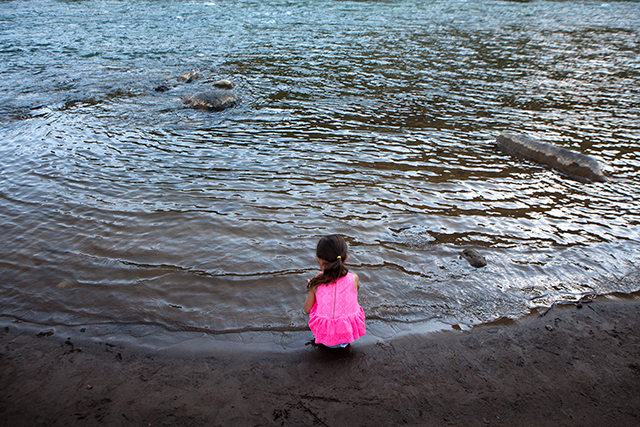This editorial first appeared at Truthout.

Emersen Sud crouches along a bank of the Animas River, in Durango, Colorado, August 14, 2015. A recent accident that leaked a toxic yellow plume of sludge from the Gold King mine into the Animas River heightened a debate over the future of this region’s old mines. (Photo: Mark Holm/The New York Times)
When Arizona Sen. John McCain met with the Navajo Nation’s tribal government earlier this month at their capital in Window Rock, Arizona, after arriving in a big black SUV, he believed he would be spending the day observing the commemoration of Code Talkers Day. This was not the case. A group of Navajo activists, incensed at the damage done to the Animas River by a toxic chemical spill from an abandoned mine, confronted the senator. Rather than address their concerns, McCain scuttled out a side door, dove into his SUV and sped down the road with the activists sprinting after him shouting, “Get off our land!”
Activists from the Navajo Nation are furious over the Animas River spill, and for good damn reason. The EPA, while attempting to evaluate the toxicity of the long-abandoned Gold King mine, inadvertently released three million gallons of hideously polluted water into the river, turning it a sickly orange color. The lead level of the released water was at least 12,000 times higher than normal, and also contained extremely high levels of beryllium, mercury, cadmium, iron, copper, zinc and arsenic. The people of the Navajo Nation rely on the river for drinking water, farming, livestock and medicine. It is a lifeline, and now it is dangerous to the touch.
The impact of the spill is not just being felt by the people of the Navajo Nation. That three million gallon orange slick of poison wended its way down the Animas River for some 300 miles until it arrived at and entered Lake Powell, a large reservoir that feeds into the Colorado River, and is a source of drinking water for many cities in the Southwest, including Las Vegas. The EPA and other government agencies are desperately deploying a “Be calm, all is well” argument, but a “team” has been formed to monitor the ongoing damage. Cold comfort indeed.
Also this month, a chemical spill on the south side of Terre Haute, Indiana, had residents fleeing with the taste of acid in their mouths and a harsh burning sensation in their throats and lungs. The Hydrite Chemical Company managed to spill an unknown quantity of sulphur dioxide. However much it was, it was enough to cause an evacuation, and residents near the spill were not allowed to return to their homes for several days.
Spectators at a local racetrack ran away with clothes over their faces to try and staunch the burning once it started to settle in. Some 20 people were reportedly hospitalized, and first responders on the scene were scrubbing down the affected on large blue mats. Sulphur dioxide is the base chemical in the making of sulfuric acid, and is also used in the processing of metal. It is profoundly toxic in every respect, a fact Terre Haute has learned the very, very hard way.
Back east in North Carolina, researchers and engineers at UNC-Charlotte are scrambling to figure out a way to properly deal with 264 billion pounds — that’s 264,000,000,000 pounds, for clarity — of highly toxic coal ash which has accumulated in the state, all of which belongs to Duke Energy. The ash is currently being stored in 32 large holes in the ground, but these holes were constructed without liners, which means the poisons from this terribly bounty — chromium and arsenic top the list — are finding their way into the water table.
Maybe they can move it to safer, lined storage basins. Maybe they can utilize other chemicals to stop the threat of the current chemicals. The situation has become a political and industry football in North Carolina, and while the lawmakers butt heads with the business magnates, while the researchers and engineers labor to find a fix, the water around those 264 billion pounds of awful gets dirtier, and dirtier, and dirtier.
Despite all this, some 15 states are currently petitioning in Federal court to thwart President Obama’s Clean Power Plan, which seeks to cut carbon emissions from power plants within the next 15 years. These states include West Virginia, Alabama, Arkansas, Florida, Indiana, Kansas, Kentucky, Louisiana, Michigan, Nebraska, Ohio, Oklahoma, South Dakota, Wisconsin and Wyoming. Some of these states, such as West Virginia, are heavily reliant on the coal industry. Others simply don’t like the federal government.
The leadership in those states dismiss the hard reality of climate change, and likely won’t believe in it until the rain turns to ashes and the seas swallow the coasts … and perhaps, not even then. Greed dies hard, even when the rivers have turned to soot and the tap water catches fire.
All this, along with all the other spills and explosions, the ravages of fracking and the Keystone XL pipeline with its gruesome tar sands oil augurs toward an irrefutable truth: We are killing ourselves with coal, with chemicals, with carelessness and with greed. The people behind all this don’t care, and won’t care until they are made to. Navajo Nation activists literally chased a sitting US senator down the road and off their lands in an attempt to force the issue.
What will you do?
The views expressed in this post are the author’s alone, and presented here to offer a variety of perspectives to our readers.
Copyright, Truthout.org. Reprinted with permission.


